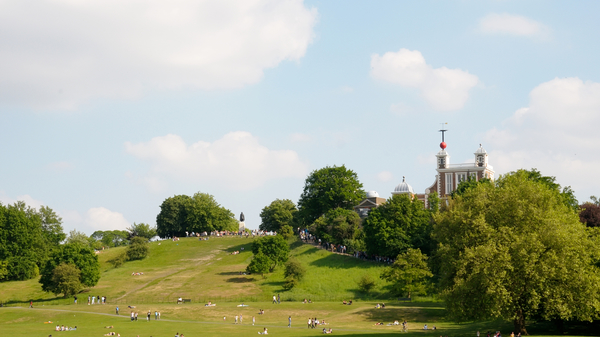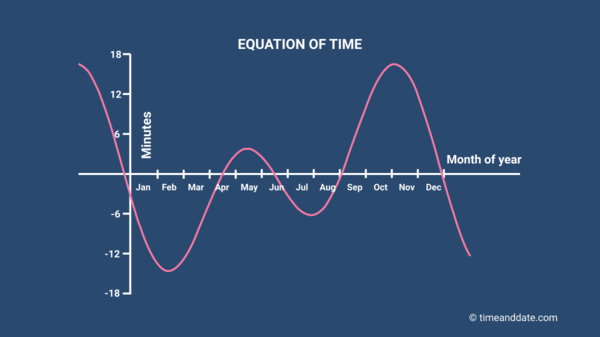
Sometimes faster, sometimes slower: the speed at which the Sun moves across the sky varies from day to day.
©iStockphoto.com/tomch
Time According to the Sun
Every day, the Sun rises somewhere in the east, and sets somewhere in the west. Along the way, it passes over an imaginary line running from north to south. At this instant, the position of the Sun is at its highest point in the sky.
The imaginary north-south line is called the meridian, and the moment the Sun crosses it is called solar noon. The time from one solar noon to the next is called an apparent solar day.
Planet Earth is an exceptionally accurate timekeeper
The Sun Is Not a Perfect Timekeeper
This form of time, measured by the Sun’s daily movement across the sky, is called apparent solar time. It can be measured by a sundial.
The motion of the Sun from east to west is caused by the rotation of the Earth—which is extremely regular. The Earth’s spin is never more than a few milliseconds fast or slow over a period of 24 hours.
How many milliseconds fast or slow is the Earth today?
We might expect, therefore, that the length of an apparent solar day would always be the same.
In fact, depending on the time of year, an apparent solar day can be up to 22 seconds shorter or 29 seconds longer than 24 hours.
Why the Speed of the Sun Varies
The variation in the length of an apparent solar day is a result of two factors.
- The Earth’s orbit is slightly elliptical—it’s a not-quite-perfect circle. When the Earth is closer to the Sun, it travels more quickly along its orbit.
- The Earth’s spin axis is tilted—around the solstices, one of the Earth’s poles is leaning toward the Sun. Around the equinoxes, neither pole is leaning toward the Sun.
Both these factors affect how quickly the Sun appears to move across our sky over the course of the year.

Unchanging: as far as clocks are concerned, a day contains exactly 86,400 seconds.
©iStockphoto.com/WestLight
Time According to Our Clocks
Our clocks and watches ignore these differences in the Sun’s movement. To these steadily ticking devices, every day is an average day of exactly 24 hours.
This form of steady, average time is called mean solar time.
The difference between apparent solar time and mean solar time is called the equation of time.
How Does the Equation of Time Work?
Let’s look at how the equation of time works, using a well-known example of mean solar time: Greenwich Mean Time (GMT).
GMT reflects the average time when the Sun crosses the meridian at the Royal Observatory in Greenwich, a borough of London in the United Kingdom.
We can check the time for solar noon in Greenwich using our Sun Calculator—the details for solar noon are given in the final two columns.
Look up solar noon for your city
The Prime Meridian
The meridian in Greenwich has played an important role in the history of timekeeping and navigation: in the 19th century, at an international conference in Washington DC, it was chosen as the north-south line representing zero degrees longitude.
Today, GMT is a time zone used in the UK and a number of other countries. In practice, it is the same as Coordinated Universal Time (UTC), which is used as the world’s time standard.
Is the prime meridian in the wrong place?

The Royal Observatory sits at the top of a hill in Greenwich Park. The first Astronomer Royal, John Flamsteed, began making observations from the observatory in 1676.
©iStockphoto.com/BreatheFitness
Solar Noon: Sometimes at 12:00 GMT...
On average, the Sun crosses the meridian in Greenwich at precisely 12:00 GMT.
In reality, this only happens on four days of the year, around the following dates.
| Date | Time of solar noon in Greenwich |
|---|---|
| April 15 | 12:00 GMT |
| June 14 | 12:00 GMT |
| September 1 | 12:00 GMT |
| December 25 | 12:00 GMT |
(The time shown in our table for the dates in April, June, and September is 13:00 local time. This is because the UK switches to British Summer Time (BST) from the end of March to the end of October. BST is one hour ahead of GMT, so 13:00 BST is the same as 12:00 GMT.)
...But Usually Before or After
On every other day of the year, the Sun crosses the Greenwich meridian earlier or later than precisely 12:00 GMT.
When the length of an apparent solar day is longer than 24 hours, the time of solar noon comes later than the day before.
When the length of an apparent solar day is less than 24 hours, solar noon comes earlier than the day before.
Some of the earliest and latest times of solar noon each year are as follows.
| Date | Time of solar noon in Greenwich |
|---|---|
| February 11 | 12:14 GMT |
| May 15 | 11:56 GMT |
| July 25 | 12:06 GMT |
| November 4 | 11:43 GMT |
What Does the Equation of Time Look Like?
We can plot these dates and times on a graph to give us a visual representation of the equation of time.
The dates run horizontally along the x-axis, from January 1 to December 31.
The difference, in minutes, between apparent solar time (as measured by the apparent motion of the Sun) and mean solar time (as measured by our clocks) runs vertically along the y-axis.
When solar noon comes after 12:00 GMT in Greenwich, the equation of time—shown by the pink line in our graph—shows a negative number of minutes.
When solar noon comes before 12:00 GMT in Greenwich, the equation of time is positive.
When solar noon comes at precisely 12:00 GMT in Greenwich, the equation of time is zero, and the pink line passes through the horizontal x-axis.


The equation of time, with the pink line showing how many minutes fast or slow the Sun is compared to our clocks and watches. A negative number means the Sun is running slow; a positive number means it is running fast. (This graph is sometimes shown the other way round—the shape of the line is the same, but it’s flipped vertically.)
The Same Everywhere
We’ve used Greenwich as an illustration, but the equation of time applies to all locations across the world.
In New York City in the United States, for example, the average time of solar noon is 11:56 EST. (It’s not precisely 12:00 EST, because New York is not in the center of its time zone.)
But—the same as for Greenwich—this average time for solar noon only happens in reality on four days of the year: around April 15, June 14, September 1, and December 25.
(In a similar way to Greenwich, New York uses Daylight Saving Time and switches to EDT from mid- March to the beginning of November—12:56 EDT is the same as 11:56 EST.)
For New York, the earliest and latest times of solar noon are the following.
| Date | Time of solar noon in New York |
|---|---|
| February 11 | 12:10 EST |
| May 15 | 11:52 EST |
| July 25 | 12:02 EST |
| November 4 | 11:39 EST |
Look up solar noon for your city
Sunrise and Sunset Times Also Vary
As well as affecting the time of solar noon, the variation in the length of an apparent solar day affects the times of sunrise and sunset, too.
This is why the latest sunrise and earliest sunset don’t happen on December 21 in the Northern Hemisphere—even though this is usually the shortest day of the year in terms of daylight.
The length of a solar day is longer than 24 hours around this time of year. So, just as the time of solar noon comes later and later every day, so do the times of sunrise and sunset.
Therefore, the latest sunrise comes after the winter solstice, while the earliest sunset comes before it.
